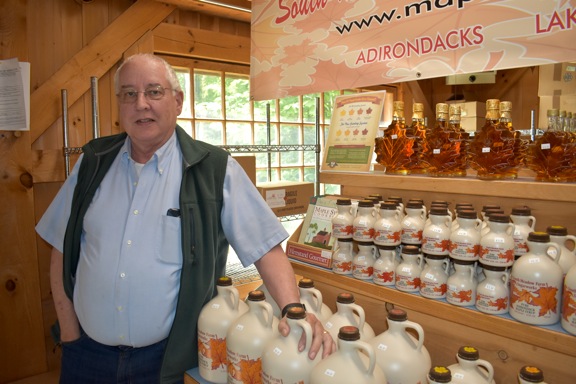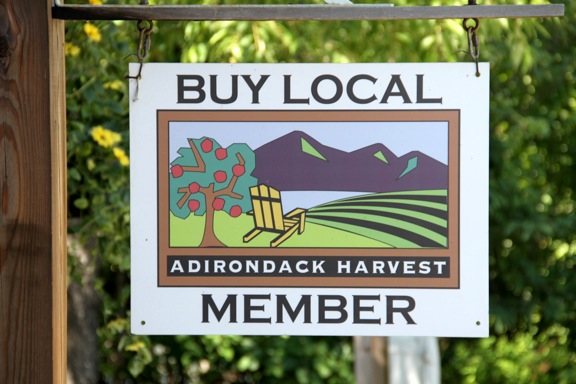SAVOR THE SEASON: Adirondack Harvest connects farms to consumers

Tony Corwin of South Meadow Farm Maple Sugarworks in Lake Placid is pictured with his products. He has been a longtime member of Adirondack Harvest and finds that it helps promote his business and other local agriculture operations. He said Adirondack Harvest is part of the local food movement and “if that movement didn’t exist, things would be different than they are now. It certainly boosted everybody’s business.” (News photo — Griffin Kelly)
LAKE PLACID – When it comes to connecting a product to a consumer, it helps to create an effective brand that people can identify – one that will be eye catching, emotionally stimulating and lead to a purchase.
Such was the case when Adirondack Harvest was founded in 2001, and it continues to be the case today as people are still learning about this brand, which means a product was harvested in the Adirondack North Country region of northern New York.
“We try to connect consumers with locally produced Adirondack food,” said Adirondack Harvest Administrator Laurie Davis, who is also the office manager at Cornell Cooperative Extension in Westport. “We do that in a variety of ways. Our most prominent tool that we have at the moment is our website, www.adirondackharvest.com.”
Adirondack Harvest is a program of Cornell Cooperative Extension. It began as a way to market locally produced food in Essex County, but it has expanded to include all of the Adirondack North Country counties: Clinton, Essex, Franklin, Hamilton, Warren, St. Lawrence, Lewis, Jefferson, Herkimer, Oneida, Saratoga, Warren and Washington.
The focus is twofold: expanding markets for local farm products so consumers have more choice of fresh farm products, and assisting farmers to increase sustainable production to meet the expanding markets. Yet it’s still about educating the public about local foods.

An Adirondack Harvest sign hangs at Green Goddess Natural Market in Lake Placid. (News photo — Andy Flynn)
“I think sometimes in this area, because we have grocery stores that are year-round, it’s a definite education for the consumer to find out that there are no ripe tomatoes in April unless somebody has done a really great job with their heated high tunnels,” Davis said. “We can produce food earlier and earlier here with the technology that’s emerging with high tunnels and other seasonal extensions. But at the farmers markets, there were always people looking for foods out of season. That’s one thing we try to do is help people to figure out there’s lots of good stuff year-round and here’s how to eat with the seasons.”
The best way to connect consumers to farmers is through the Adirondack Harvest website, which was recently overhauled to be more friendly to mobile devices. Through the map, people can track down locally produced food, restaurants that use local ingredients and stores that carry local food.
“When we started Adirondack Harvest, the website was critical because a lot of our farmers did not have their own websites and some of them barely had email,” Davis said.
Even today, many farmers don’t have websites, although most have social media accounts using Facebook, Twitter and Instagram.
—
Need for Adirondack Harvest
Finding local food is easier today than it’s been in a long time, especially here in Essex County where locally grown and produced food is making a comeback thanks to new farms and businesses. But that wasn’t always the case. In the late 1990s, county leaders were getting concerned about farms going out of business and the loss of farmland.
In 1880, the number of farms in Essex County peaked at 2,752, according to the Essex County Historical Society. But that was when subsistence farming was the norm – growing food to stay alive. Today, people farm to earn a living, not simply to put food on their tables.
The problem: If farmers can’t make their operations profitable, they go out of business, and that was happening with increasing alarm in the late 20th century.
The solution: Adirondack Harvest.
“It grew out of a farmland protection plan that Essex County and the Board of Supervisors had put together,” David said. “They received funding from the state [which] helped them to decide what was needed in Essex County in terms of preserving farmland, and one thing they decided was that farmland would be best protected if farmers could keep farming it and keep the farmland open. What better way to keep them farming than to make sure that they have profitable opportunities.”
The early driving force behind Adirondack Harvest was former Keene Town Supervisor Tom Both, according to Davis.
“As then chair of the Economic Development Committee, Tom, along his wife Alana and many others organized the early meetings to visualize, organize and eventually implement the Adirondack Harvest program,” she said.
With a mission statement in hand, Adirondack Harvest went to work.
VISION: We envision a picturesque and productive working landscape connecting local farmers to their communities and regional markets.
GOAL: Our goals are to increase opportunities for profitable, sustainable production and sale of high quality food and agricultural products, and to expand consumer choices for locally produced healthy food.
MISSION: This mission ensures the future preservation and growth of our open farmland while providing a diversity of healthy food products for consumers.
—
Success
It’s one thing to say Adirondack Harvest has been successful in connecting consumers to local food producers over the past 17 years. Yet it’s another to see the numbers that support such a claim.
Since 2002, there has been an increase in direct market farmers in Essex County. The latest Ag Census figures (2012) show that the total number of direct market farms went up 82 percent – from 38 to 69 – and direct to consumer sales went up 361 percent – from $284,000 to $1,309 million – since 2002, according to Davis.
Adirondack Harvest can’t take all the credit for the rebound of small farms and producers in Essex County. Cornell Cooperative Extension, for example, provides education for farmers. There have been grant programs to help farmers with season extension technology such as high tunnels and solar panels to heat greenhouses. And more farmers in the region are using Community-Supported Agriculture models to raise capital to make it through the slower winter months.
“We knew what those were, but the consumer didn’t,” Davis said about CSAs. “It took a really long time for those to pop up around here.”
Consumers essentially have many more options to get their local food than they did 20 years ago, including CSAs, farmers markets and farm stores.
“I don’t think we had local cheeses back then, and now we have three creameries in Essex County,” Davis said, adding that those creameries eventually led to the Essex County Cheese Trail tour held in October. “We decided that two creameries were great, but as soon as we had three, well, that’s a trail, so let’s just do it.”
When Adirondack Harvest began, many consumers were limited to buying their local food in the growing months – late spring, summer and early fall. But that’s all changed.
“Now at these farm stores, you can find things year-round: the meat, the cheese, the root vegetables, honey, maple, all of the things we were producing around here but now you can get them year-round,” Davis said.
As for using the website, Davis shared one success story that recently connected a restaurant in Old Forge with one of her new board members, Jeffrey Van Arsdale, who operates Cedar Hedge Farm in Lowville. He makes goat cheese.
“He said because of this affiliation, they were cold called by an Old Forge chef looking to use locally sourced menu items,” she said. The chef was familiar with Adirondack Harvest farmers in the High Peaks area, “and he knew their passion for farm to table. … He needed a new source of cheese, went to the Adirondack Harvest website and found Cedar Hedge Farm – huge boost in business – and the chef is using his cheese on the menu now.”
—
Challenges for the future
Even though Adirondack Harvest officials can see tangible results of their marketing efforts, the job is far from done. There is still a lot of consumer education needed, and start-up farmers still need help finding markets. The question is, can Adirondack Harvest do it alone, or does it need the ongoing support of Cornell Cooperative Extension?
Twelve years ago, Davis was hired to coordinate Adirondack Harvest. Today, she’s administrates the program as the office manager at CCE.
“As I grew into the position, I realized how interconnected CCE and Adirondack Harvest were,” she said. “CCE has been a great support system for Adirondack Harvest. We are able to connect with Cornell and a lot of research-based information that can help the farmers. And just being part of CCE has helped us to find farmers and just be so much more for them than we could be alone.”
Yet being associated with CCE limits what Adirondack Harvest can eventually do for farmers.
“CCE’s mission is entirely education-based,” Davis said. “And that’s great to a certain extent, but Adirondack Harvest also wants to be a marketing organization and possibly branching into local food delivery and distribution.”
That could be a pilot program under the CCE banner, but a permanent solution would be for Adirondack Harvest to exist as a separate entity, which is something the advisory board members are researching. One hurdle is to come up with a way to sustainably fund the program beyond the membership dues, which are minimal at $25 a year for businesses.
To help producers market their goods, Adirondack Harvest has developed and copyrighted a logo to identify products grown or made in the Adirondack region. It has also printed signs, stickers and banners for members to use.
“Our hope for the future is that our members start really using the logo more and that consumers look for that logo so they know they’re getting local food,” Davis said. “On a personal level, I really would like to see Adirondack Harvest take off as a strong regional brand that is also involved in helping farmers to move their product.”
Distribution is key, according to Davis. While some producers have found ways to move their goods to markets throughout the region – even as far as New York City – she said it only makes sense for farmers to pool their resources.
“I think that we don’t need a whole lot of different farm trucks on the road making deliveries,” Davis said. “If we can work together, a cooperative way is just more efficient for everyone and most beneficial to our farmers and the consumers who will end up having more choice.”
In the future, Davis would like to bring on a full-time marketing person at Adirondack Harvest. After all, there’s still plenty of work to be done. There always will be.
“Agriculture, even though it feels like a very traditional thing,” she said, “it’s also ever changing and marketing is changing. If we can keep agriculture strong in the North Country, it’s just going to benefit everyone.”
Agriculture doesn’t always mean food, and Adirondack Harvest isn’t just limited to food items. The organization also has fiber members, such as alpaca farms, and forestry producers are the newest members. Davis said she is looking for artisans who use wood from the Adirondacks, plus maple producers and lumber yards using local wood.
“It’s something that people don’t always thing of when they think of Adirondack Harvest, but it’s a product harvested in the Adirondacks and we’re trying to get them promoted as well.”
- An Adirondack Harvest sign hangs at Green Goddess Natural Market in Lake Placid. (News photo — Andy Flynn)



